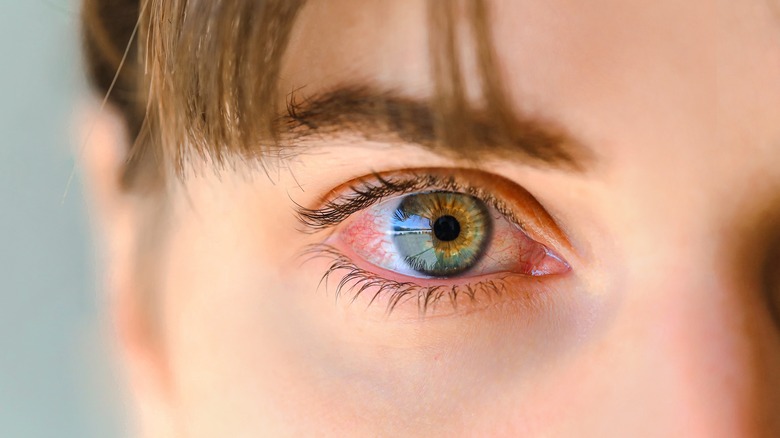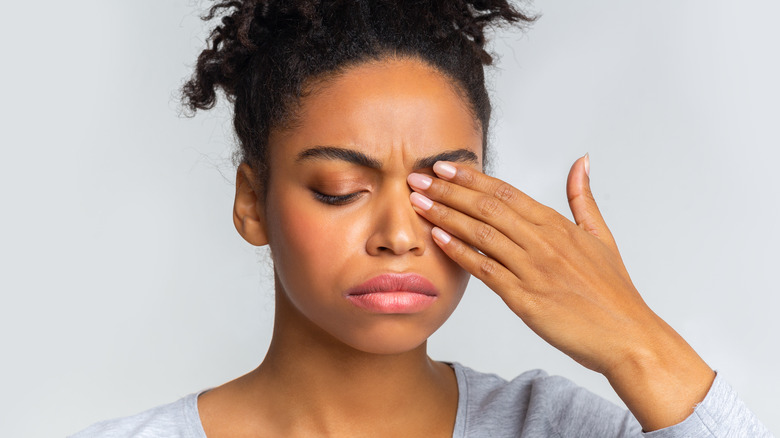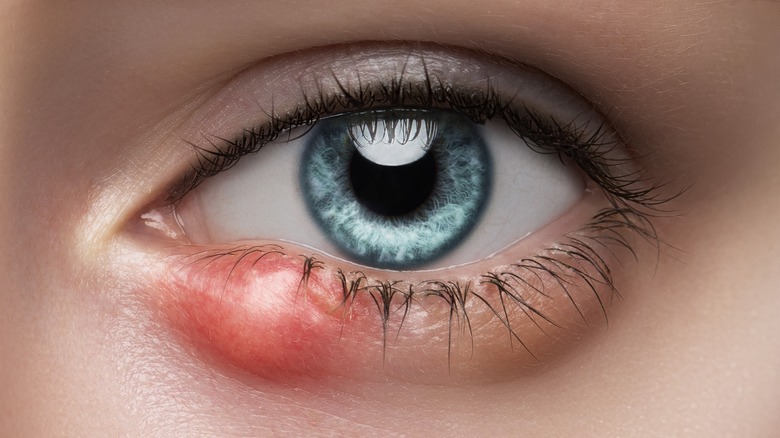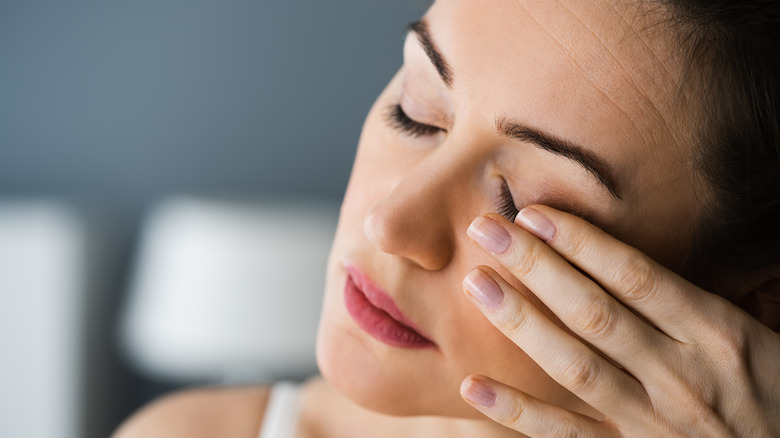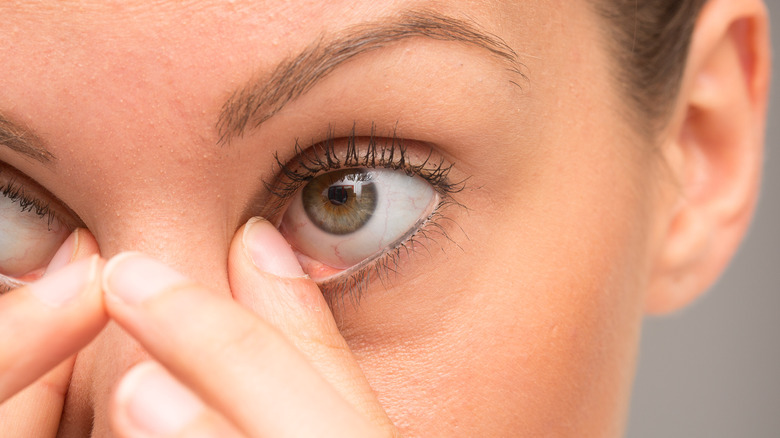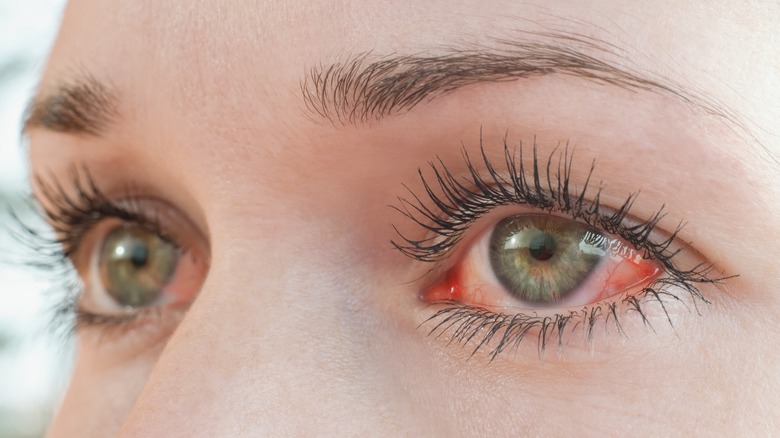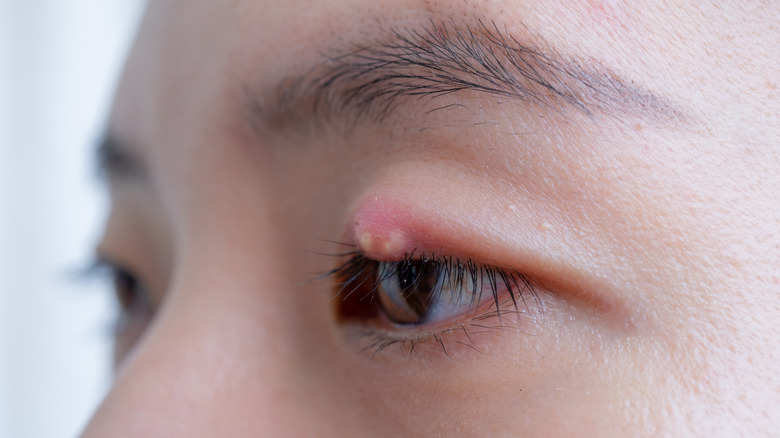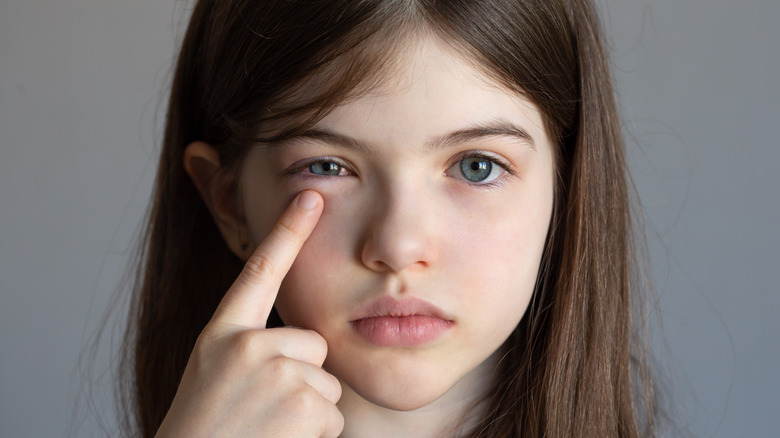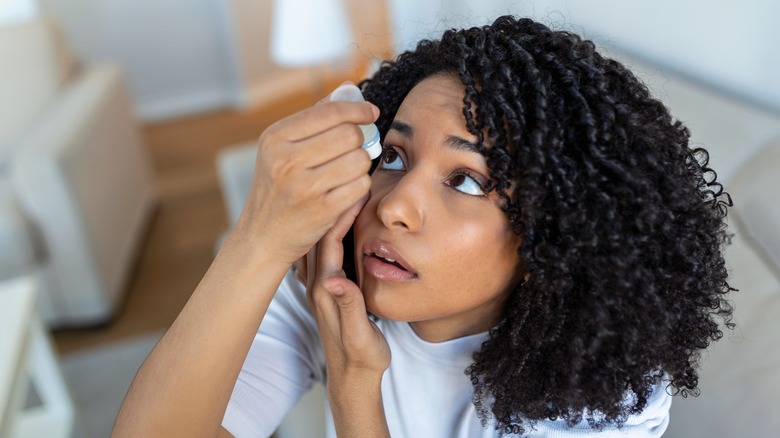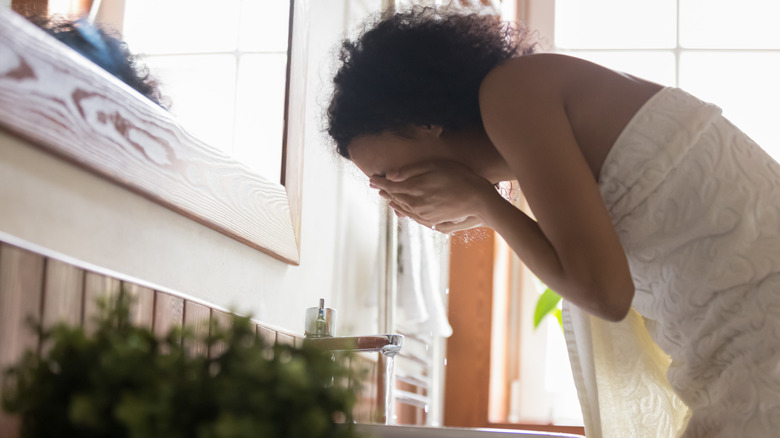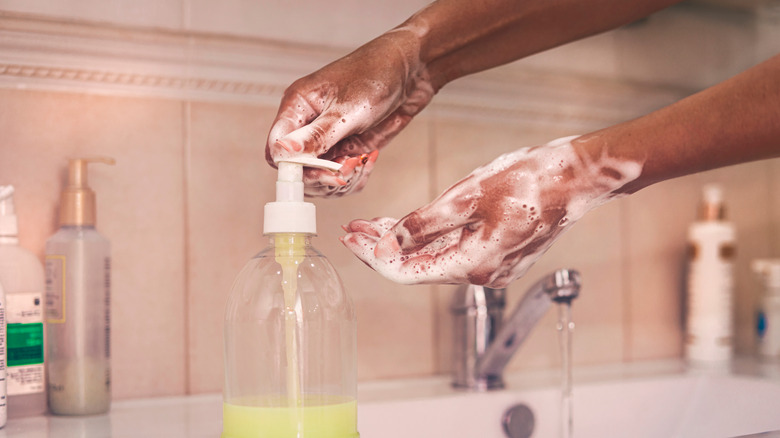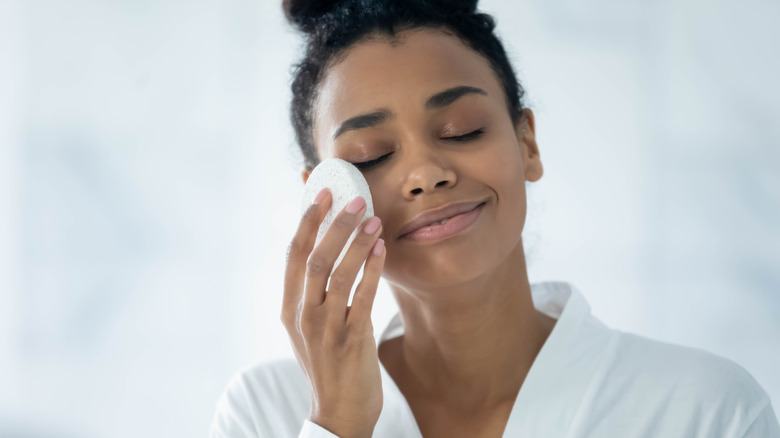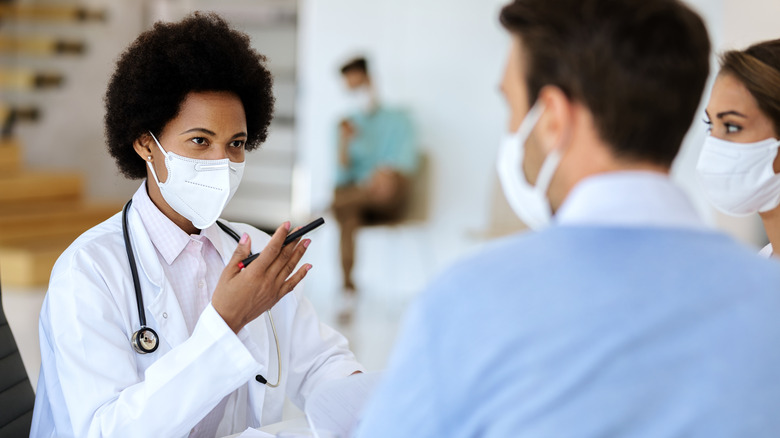Pink Eye Vs Stye: What's The Difference?
Pink eye, also referred to as conjunctivitis, is a pretty common condition. As the name indicates, pink eye typically causes the eyes to adopt a red or pinkish color. This results from an infection in the blood vessels found in the eye's conjunctiva, an invisible layer covering the white parts of the eye and your inner eyelid (via Healthline). Children are especially vulnerable to pink eye, according to WebMD, but luckily it's rarely serious, and people don't usually experience any damage to their vision. The trick is to treat it as quickly as possible.
Styes, also referred to as a hordeolum (via Healthline), is more like an eye pimple and is the result of a blocked oil gland on the eyelid. Various things can cause this blockage, but bacteria is usually the culprit. In some cases, the gland gets blocked by dead skin cells and germs, according to WebMD. The result is a small pimple next to an eyelash that steadily grows into a big, painful bump filled with pus. The healing process only starts once the stye bursts. Typically, this doesn't take too long, and styes don't usually require medical treatment, though more serious cases might warrant a visit to the doctor.
Read on to discover the main differences between pink eye and styes and how to treat them successfully.
Pink eye symptoms
The symptoms of pink eye might vary depending on the root cause of the infection. One of the most common symptoms is the sensation that there's something stuck in the eye. Some people also experience a gritty feeling that won't go away, according to the American Academy of Ophthalmology. Other common symptoms include red, burning, or itchy eyes. In some cases, people might even experience pain in the area. Watery eyes, along with puffy eyelids, are other telltale signs that you might be suffering from pink eye.
Some also experience hazy or blurry vision as well as a sensitivity to light. Pink eye can also cause the eye to produce a discharge in the form of pus or mucus, and contact lens wearers might notice that their lenses no longer feel comfortable or are moving around on their eye, according to the CDC.
The discharge from the eye can be so intense that it causes your eyelashes and lids to stick together, making it hard to open your eyes after a night's sleep. Experiencing any of these symptoms warrants a visit to your doctor so they can examine your eye and determine whether it's pink eye or something else.
Stye symptoms
Stye has symptoms that overlap with that of pink eye, but the main difference is that you'll notice a lump on your eyelid as well. According to Healthline, styes can also cause eyelids to swell, and it's common for the eye to have a yellow-colored discharge. Light sensitivity is another symptom stye and pink eye have in common, as well as the feeling that there's something stuck in the eye. A sore eyelid is another telltale sign of stye, along with an eye that is watery. Stye can also cause the eyelid to become red, and the discharge from the eye or the stye itself can cause a crust to develop on the eyelid's edge.
While many of these symptoms appear to be similar to pink eye, the bump that accompanies the stye will be a dead giveaway. According to Medical News Today, the bump typically looks like a pimple on your eyelid, and it's usually located pretty close to your eyelashes. If you're still on the fence about whether or not it's a stye, check for a tiny yellow spot in the middle of the bump. If you have all the abovementioned symptoms but have a bump that feels hard and doesn't cause you any pain, you might actually be dealing with a chalazion. While the causes are the same, a chalazion can take up to a month to heal without treatment, according to Mount Sinai.
Pink eye causes
As previously mentioned, pink eye is the result of inflammation in the conjunctiva, and a myriad of things can trigger this inflammation, the most common of which is viruses. The virus that causes COVID-19 or even common colds can lead to the development of pink eye, according to Cleveland Clinic. Pink eye can also be triggered by sexually transmitted diseases like herpes simplex or chlamydia and gonorrhea. Pink eye triggered by gonorrhea can sometimes be incredibly dangerous and can lead to a person losing their vision if it isn't treated properly, according to WebMD.
Those who suffer from autoimmune diseases can also develop pink eye, but it's rare for this to be the cause. Having a foreign object stuck in the eye can cause inflammation that leads to pink eye, as well as allergens like pollen or molds. In some cases, people might find that exposing their eyes to chlorine in pool water, smoke, shampoo, and makeup can trigger pink eye. Contact lens irritation can cause this condition to develop as well as using eye drops that don't agree with your eyes. Certain strains of bacteria are also notorious for causing pink eye, including Pseudomonas aeruginosa, Staphylococcus aureus, Streptococcus pneumonia, and Haemophilus influenzae. Certain parasites, fungi, and amoebas can also cause pink eye. In babies, pink eye is usually the result of tear ducts that are either only partially open or completely blocked.
Stye Causes
When it comes to the causes of stye, the list is much shorter than that of pink eye. While various bacteria, viruses, and environmental factors can contribute to the development of pink eye, styes are simply the result of a blocked oil gland or hair follicle, and the culprits are usually either bacteria or other debris like dead skin cells, according to Medical News Today.
Various bacteria can cause styes, but a 2019 overview published in the National Library of Medicine found that the Staphylococcus bacteria is usually the main cause.
While the cause of styes is pretty straightforward, some people are more prone to developing these pesky, painful bumps. It turns out that, if you've had a stye once, chances are good you might get another. Some chronic medical conditions that affect how well the immune system functions, like diabetes, can also trigger styes. Medical conditions that affect the skin, like dermatitis and rosacea, can also make people more prone to developing styes. If you wear contact lenses and don't handle or clean them properly, they can also put you at risk of developing these bumps. Sleeping with contacts or reusing daily lenses can also increase your risk (via Healthline). Last, but not least, using expired cosmetics or sleeping without removing your eye makeup can also cause oil glands and hair follicles on the eyelid to become blocked, leading to the formation of styes.
Pink eye needs to be diagnosed by a doctor
If you suspect you or your child has pink eye, it's important to seek medical care. According to Johns Hopkins Medicine, you'll need an eye specialist to diagnose the condition and figure out what's causing your specific case of pink eye.
Typically, the doctor will ask you about your medical history. It's important to tell them if you recently suffered from any bacterial or viral infections since this can help them with the diagnosis. Also, mention if you've exposed your eyes to irritating substances like foreign objects or chemicals. If you previously had or currently have a sexually transmitted disease, it's important to tell your doctor as well. You can also mention any allergies you have, and if your family has a history of autoimmune diseases, it's a good idea to make your doctor aware of that as well (via Cleveland Clinic).
Once your medical history is covered, your doctor will proceed to take a look at your eyes. Usually, your medical history and symptoms are enough to make a diagnosis. In some cases, your doctor might ask you to do an eye chart test so they can assess whether pink eye is affecting your vision. If your eye is producing a lot of discharge or pus, your doctor might also do an eye swab so they can rule out other conditions, but it's usually not required when your symptoms aren't severe.
Styes can sometimes be self-diagnosed
A stye can typically be identified without consulting a doctor. Having all the symptoms associated with a stye, along with a bump on the eyelid, is usually a dead giveaway. Normal styes that improve rapidly will typically go away without medical treatment, according to Cleveland Clinic, so in most cases, people can identify a stye and deal with it until it bursts and starts to heal. Some styes, however, can be a bit more stubborn and completely overstay their welcome, and if it seems to only be getting more painful over a prolonged period of time, it might be time to seek medical help.
While pain alone sometimes isn't enough to convince people to consult a doctor, you really should make an appointment if styes won't take their leave or start to affect your vision. You won't have to go through a series of tests to determine whether it's a stye — your doctor will typically be able to diagnose it by simply examining your eyelid (via Johns Hopkins Medicine). They might also ask you if you experience any other symptoms. For stubborn styes that tend to recur, your doctor might prescribe you an eye ointment that contains antibiotics. In pretty severe cases, some doctors recommend that patients opt for a procedure that consists of opening the stye and cleaning it thoroughly.
There are different types of pink eye
There are different types of pink eye you can suffer from, and they're typically divided into three categories: chemical, infectious, and allergic (via Healthline).
Chemical pink eye usually develops when your eyes are often exposed to chemicals, air pollution, or the chlorine found in swimming pools. Allergic pink eye is usually the result of seasonal allergies. If you notice pink eye popping up at certain times of the year when there's a lot of pollen in the air, allergies are likely the cause. Symptoms usually include itchiness and tearing, as well as a runny and itchy nose. Something else that can trigger a type of allergic pink eye known as giant papillary conjunctivitis is contact lenses. Some soft and hard contact lens wearers find that they trigger this condition when they fail to replace their contacts accordingly.
Infectious pink eye includes viral and bacterial infections. Viral pink eye is the most common and typically triggered by colds and the flu. It's also the most contagious form of pink eye, according to WebMD. Typically, the infection will start in one eye and then pass to the other eye. Tears and discharge are common with this infection. When pink eye is bacterial, it's usually limited to one eye and is accompanied by a discharge of mucus and pus. Streptococcal and Staphylococcal bacteria are usually the main culprits. Ophthalmia neonatorum is a type of bacterial pink eye that infects infants and can lead to damaged eyes or even vision loss if not treated.
There are different types of styes
While the causes of stye are less complex than that of pink eye, there are two variations that can occur, according to Cleveland Clinic.
You might get an internal or external stye, depending on the oil gland that becomes blocked. Internal styes refer to bumps that appear on your inner eyelids, which means this type of stye is technically inside the eye and isn't as easy to spot at first. Styes on the inside of the lid start to form when one of the oil glands in the inner eyelid that are responsible for keeping the eye lubricated becomes blocked and infected.
External styes are easier to spot and are the ones that appear on your eyelids. These styes are the most common and are typically caused by blocked eyelash follicles. You can get styes on both your eyelids at once, but it's more common to get it on one eyelid at a time.
Pink eye can be contagious, but styes are not
Viral and bacterial pink eye is extremely contagious. For example, if you absentmindedly touch your infected eye, then touch someone's hand, who then ends up rubbing or touching their eye, the chances are good that they will get the infection as well (via Healthline).
As long as you have symptoms of pink eye, you can spread it, especially if you have mucus or pus coming out of the eye, according to Johns Hopkins Medicine. Other signs that you're contagious include crusts forming on the lashes or lids, swelling around the eye, red or pink-colored whites, and experiencing a burning sensation in the affected eye (via Medical News Today). It's also important to keep in mind that the virus has the ability to survive outside of the eye and can continue to live on surfaces for around two weeks, so make sure you wash your hands regularly.
While pink eye can spread like the plague, styes, on the other hand, are not contagious at all. While they're painful, you won't have to take time off work to keep your colleagues from becoming infected (via WebMD).
Pink eye treatment
The treatment your doctor prescribes will depend on what's causing your pink eye. If a viral infection is the cause, there isn't much you can do except wait it out — your body will take care of it. The American Academy of Ophthalmology recommends you treat viral pink eye at home by putting a cool, wet cloth over your eyes to ease discomfort.
If allergies are behind your pink eye, your doctor will typically prescribe some eye drops that will help ease the puffiness and itchiness you experience. According to Healthline, your doctor might also prescribe an oral antihistamine, which will help clear up allergic symptoms, including those causing pink eye. Chemical conjunctivitis is usually treated with eyedrops or ointment, depending on the severity. Rinsing the eyes with saline is also a common treatment. If a bacterial infection caused your pink eye symptoms, your doctor will usually prescribe antibiotic eye drops or ointments. It's important to finish antibiotic treatment to prevent pink eye from recurring.
Stye treatment
Stye treatments usually consist of home remedies. The first and most important thing you need to keep in mind when treating a stye is that popping the bump is under no circumstances considered "treatment." In fact, this could worsen the infection and cause it to spread to the rest of your eye, according to WebMD.
Your focus should be on relieving discomfort caused by the stye while being careful not to aggravate it. Johns Hopkins Medicine recommends you refrain from touching the area and wash your hands often. Regularly washing your face, including your eye area where the stye resides, will help keep it clean while it heals. If the stye is very uncomfortable, you can put a warm compress on your eyelid to help ease the pain. Five to 10 minutes usually do the trick. It is recommended you take the time to treat the eye with a warm compress three to five times a day. Last, but not least, avoid applying makeup (especially eye makeup) if you can. Not only will it help the infection to heal faster, but it will also ensure you don't get any of the existing bacteria on your makeup tools.
If a stye is sticking around longer than it should and is incredibly painful, your doctor might prescribe an antibiotic ointment you can apply to the stye to help it heal faster. If your stye becomes chronic, your doctor might refer you to an ophthalmologist for further treatment.
Pink eye can be prevented
While pink eye can be frustrating to deal with, there are some small steps you can take to prevent it from occurring.
When it comes to pink eye, figuring out what the root cause is for you specifically is the key to avoiding it, according to WebMD. If allergies are usually the culprit, try to avoid the things that trigger them, and if your eyes do start to become irritated, refrain from rubbing them and use artificial tears to help ease discomfort. Using allergy medication can also help. If you get chemical pink eye, checking in with the contact lens solution you use might be helpful. Sometimes, certain solutions can irritate the eyes.
If viral or bacterial infections tend to be the cause, take care to wash your hands often and refrain from touching your face and eyes during the day. It's also wise to always use your own cosmetics (especially those you apply around the eye area) and eyedrops instead of borrowing from someone else. Sharing facecloths, pillowcases, and bath towels is another no-no.
There are some things you can do to prevent styes
When it comes to preventing styes, keeping your eye area as clean as possible is key, according to Master Eye Associates. Refraining from sharing makeup is another way to prevent styes, as well as ensuring you clean your face and eye area thoroughly every night. It's also wise to throw away old makeup, which might harbor bacteria. Taking supplements like flaxseed or fish oil has also been shown to be able to help prevent styes from popping up. These supplements work to keep oil glands healthy and promote oil flow, which can prevent blockages from occurring.
If styes are something you deal with frequently and the usual preventative measures and supplements don't seem to work as well, you could opt for an eyelid scrub. This will help prevent blockages of the oil glands and hair follicles.
Sometimes, styes are hard to prevent, according to the NHS. This is because we can't always control the bacteria that enter oil glands and follicles. People who suffer from chronic blepharitis and rosacea are also naturally more prone to developing styes. The best you can do is to simply keep your eyes as clean as possible.
When you should see a doctor
It's important to seek medical care if you suspect you have pink eye, especially because it can be contagious. Your doctor will also be able to rule out any other possible causes of your symptoms. According to the Mayo Clinic, you should make an appointment if you experience a sensation that there's something stuck in your eye, experience pain in the eye, or develop light sensitivity and blurry vision. If you wear contact lenses, remove them as soon as symptoms start and consult your doctor.
While we've established that styes are typically less serious than pink eye, it's still crucial you pay a visit to your doctor if at-home remedies fail to treat it. Medical News Today recommends you make an appointment with your doctor if styes stick around for longer than a few days despite treatment. If the stye starts bleeding, causes redness on your cheeks or face, gets worse at a rapid rate, or starts to interfere with your sight, make an appointment ASAP.

